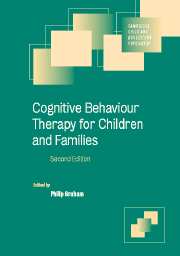Book contents
- Frontmatter
- Contents
- List of contributors
- 1 Introduction
- Part I Developmental cognitive theory and clinical practice
- Part II Engagement and assessment
- Part III Client groups
- Part IV Applications in psychosocial adversity
- Part V Applications in specific child and adolescent psychiatric disorders
- 12 Behavioural approaches to eating and sleeping problems in young children
- 13 Conduct disorders in young children
- 14 Attention deficit hyperactivity disorder
- 15 Children with developmental disabilities and their parents
- 16 Depressive disorders
- 17 Cognitive behavioural psychotherapy for obsessive compulsive disorders
- 18 Anxiety disorders
- 19 School refusal
- 20 Post-traumatic stress disorders
- 21 Disorders of eating control
- 22 Chronic fatigue syndrome
- 23 Children's interpersonal problems
- 24 Pain in childhood
- 25 Conduct disorders in adolescence
- 26 Drug and alcohol abuse
- Part VI CBT applications in preventive interventions
- Index
- References
16 - Depressive disorders
Published online by Cambridge University Press: 21 August 2009
- Frontmatter
- Contents
- List of contributors
- 1 Introduction
- Part I Developmental cognitive theory and clinical practice
- Part II Engagement and assessment
- Part III Client groups
- Part IV Applications in psychosocial adversity
- Part V Applications in specific child and adolescent psychiatric disorders
- 12 Behavioural approaches to eating and sleeping problems in young children
- 13 Conduct disorders in young children
- 14 Attention deficit hyperactivity disorder
- 15 Children with developmental disabilities and their parents
- 16 Depressive disorders
- 17 Cognitive behavioural psychotherapy for obsessive compulsive disorders
- 18 Anxiety disorders
- 19 School refusal
- 20 Post-traumatic stress disorders
- 21 Disorders of eating control
- 22 Chronic fatigue syndrome
- 23 Children's interpersonal problems
- 24 Pain in childhood
- 25 Conduct disorders in adolescence
- 26 Drug and alcohol abuse
- Part VI CBT applications in preventive interventions
- Index
- References
Summary
There is no longer a debate about the existence of major depressive disorder in late childhood and adolescence. Reported prevalence in adolescence ranges from 1% to 6% of the general population, with a recent British study finding that approximately 2% of adolescents had had a recent episode of major depression (Meltzer et al., 2000). Rates in children are much less, probably in the order of one per 1000. There is a great deal of comorbidity with other emotional disorders and also with conduct disorder. Follow-up studies have demonstrated that young people with depression have a greater risk of subsequent episodes than non-depressed psychiatric cases. There is also an increased risk of both attempted and completed suicide.
A variety of treatments are now available for major depression in young people. For example, recent findings suggest that the serotonin-specific reuptake inhibitors (SSRIs) can be effective (Emslie et al., 1997; Keller et al., 2001; Emslie et al., 2002). However, in many cases, psychological treatments are currently the preferred first line of treatment. Several different psychological treatments have been evaluated for depressed children and adolescents. Probably the best evaluated are the cognitive behavioural therapies (CBTs).
This chapter provides a practical account of CBT for depression in late childhood and adolescence. The chapter begins with a brief overview of the theory behind CBT and some general principles of treatment. The core CBT techniques are then described. The chapter concludes with a brief overview of the evidence base for CBT.
- Type
- Chapter
- Information
- Cognitive Behaviour Therapy for Children and Families , pp. 263 - 280Publisher: Cambridge University PressPrint publication year: 2004
References
- 1
- Cited by



